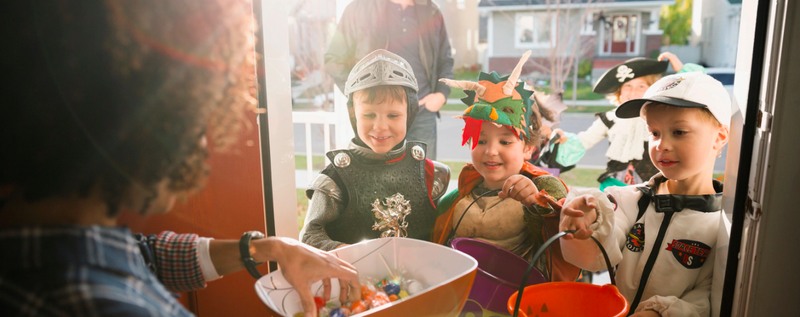This article will ...
- Highlight the benefits of withholding some of your child’s candy after trick-or-treating and the lessons it can teach about delayed gratification.
- Suggest a simple strategy for teaching your kids the concept of taxation on Halloween night. Warning: they may not like it.
- Explain how the ritual of swapping candy with friends can teach your kids about money and market value.
Halloween is the perfect opportunity to let your child channel their creativity and indulge their sweet tooth, in moderation, but it can also provide the perfect backdrop to teach your kids some valuable life lessons about money management.
These Halloween lessons for kids include:
- Saving
- Charity
- Taxes
- Market value
- Budgeting

Saving
Counseling your kids to consume their candy slowly doesn’t just prevent a tummy ache. It also gives them a chance to hone their budgeting skills.
It’s a tough sell at first, but the benefits quickly become clear when they still have half their haul in mid-November and their friends (or siblings) have nothing left but empty wrappers.
“I think one of the strongest lessons kids can learn from Halloween is delayed gratification,” said Robin Giles, a financial professional with Apex Wealth Management in Katy, Texas, in an email interview. “When I was growing up, I would limit myself to one or two candies in a day and I had Halloween candy for months. My sister would eat all of her candies and they’d be gone in less than a week. I didn’t know it was ‘delayed gratification’ at the time, but I really learned that lesson and started applying it in other areas of my life.”
Birnbaum said he also uses Halloween to teach his son to save.
“Early on, my wife and I convinced our son to eat just a little bit of his candy on Halloween and save the rest for later,” he said. “We put the leftover candy in a special ‘treasure chest’ for him.”
Keeping his candy stash out of reach helped to moderate his impulse control, but Birnbaum said he could ask for a piece of candy when he wanted. If he asked for candy, and it wasn't right before dinner or bedtime, they would bring out the treasure chest and allow him to choose a controlled amount of candy. Birnbaum noted his son is now in college and an excellent saver.
For older kids, however, don’t be afraid to give them more control over their candy haul. If they choose to ignore your advice, that’s OK, too. Mistakes can be an excellent teacher.
Charitable giving
Kids may not have deep pockets to support their favorite charity, but as Halloween rolls around, don’t forget that candy is a commodity that can be shared.
“Halloween can help reinforce the value of charitable giving,” said Birnbaum. “While not a financial lesson per se, it is still a worthwhile lesson to teach.”
Indeed, nonprofits like Soldier's Angels redistribute donated candy through its Treats for Troops program to VA hospitals, military bases, and guard and reserve units, often in exchange for “goodies.” Operation Shoebox also distributes donated candy to troops who are stationed away from home. And local chapters of the Ronald McDonald House Charities often accept unopened Halloween candy for sick children and their families.
Homeless shelters and senior centers that care for housebound elders also generally welcome donations of unopened candy.
Birnbaum said your child need not sacrifice their entire Halloween haul to enjoy the emotional payoff of philanthropy.
“The key is to reinforce a child's donating a portion of their candy with lots of positive feedback,” he said. “Also, the child's parents can set a positive example by donating candy they have purchased.”
Money management for kids: The candy tax
There’s nothing certain, as they say, but death and taxes. As you dodge the grim reaper on your trick-or-treating route, why not take the opportunity to collect a “mom or dad tax” or "candy tax" on their haul to help support the cost of shared resources, said Howard Pressman, a financial professional with Egan, Berger & Weiner, LLC, in Vienna, Virginia, in an email interview.
“I decided to teach my daughter a lesson on taxes on Halloween,” he said, only partly tongue in cheek. “I take some of her candy in exchange for providing shelter and food.”
You need not complicate things with payroll jargon or sales tax rates. The concept of taxation will be painfully clear when you get them to fork over one of their favorite treats.
Be prepared for pushback, said Pressman.
“She doesn't much care for this, but I get to eat Tootsie Rolls,” he said, noting the conversations on Halloween night have opened the door to deeper discussions as his child ages.
“It initially started as a way for me to have some of her loot, but as she's gotten older, it's morphed into a substantive conversation about what taxes are, why we have to pay them, and how the two political parties differ in their approach. She obviously thinks this is tremendously unfair, but she gets it.”
Market value and candy
The concept of value is central to successful money management. For example, investors determine whether to purchase shares of a company based upon, among other factors, its total worth, or its market capitalization.
Similarly, consumers decide on a daily basis whether the costs of goods and services are fairly priced based on their intrinsic value and the benefits of ownership.
Determining value comes naturally to kids, especially on Halloween night when they engage in bartering among their circle of peers, said Alexander Rupert, a financial planner with Laurel Tree Advisors in Cleveland, Ohio.
“Once a group of friends forms and they decide to start swapping candy, they are essentially creating their own market,” said Rupert. “This is the beginning of a much more complicated concept, but it lays a foundation.”
As each child takes inventory of their haul, they quickly realize that all candies are not valued equally among their peers.
“When Tyler offers Dominick a Smarties for a Reese's Cup, Dominick will most likely say ‘No way,’” said Rupert. “Tyler will have to offer more candy or other candy to make a more compelling offer.”
And, while Eric was the most industrious and collected the most candy, he may quickly learn that his stash is not as valuable as the others because he missed the house that was handing out full-size chocolate bars.
“Halloween can be an opportunity for kids to start understanding the concept of value and how more isn't always more,” said Rupert.
Use money wisely
According to personal finance website Bankrate.com, the typical kid’s costume costs about $33. High-end costumes cost hundreds of dollars or more.
Before you break the bank to convert your toddler into a superhero or fairytale princess, try using what you’ve got at home.
Do-it-yourself costumes made from old boxes, recycled pie pans, and worn out clothes cost nothing at all. Not only will you get a chance to craft with your kid, you can assure them that their costume will be one of a kind.
“With young children, a lot of times parents could be putting together costumes with clothing and dress up clothes they already have in the house,” said Todd Youngdahl, a financial professional with Washington Wealth Advisors in Falls Church, Virginia, in an email interview.
Youngdahl’s youngest daughter wants to be a cheerleader, for example, a costume they already have in their house. For his 8 year-old daughter, who wants to be a football player, they intend to ask the gym teacher at the school where his wife works if they can borrow shoulder pads from the pee-wee team.
“Borrow and piecemeal!” he said.
Similarly, as you stock up on candy for trick-or-treaters, involve your kids. Let them help you comparison shop and show them how to stretch your dollar further by buying items that are on sale or shopping at bulk discount stores, if you are a member.
In their sugar-induced frenzy, they might even be more receptive to mom and dad’s words of wisdom.
MM202610-307040


